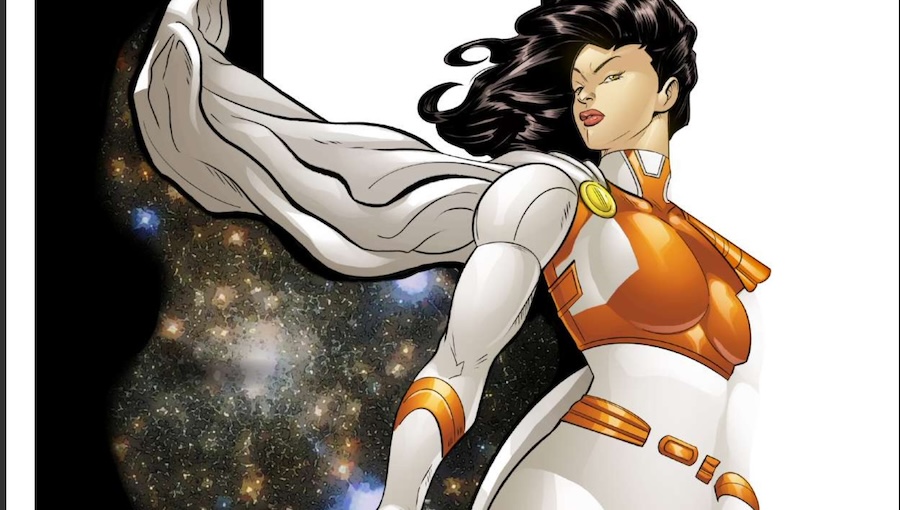The following is an interview with Max Ferrada regarding the release of the sci-fi comic book series, Stellarlands. In this interview, Fanbase Press Editor-in-Chief Barbra Dillon chats with Ferrada about his shared creative process in bringing the story to life on the page, what he hopes that readers may take away from the story, and more!
Barbra Dillon, Fanbase Press Editor-in-Chief: Congratulations on the release of Stellarlands! For those who may be unfamiliar, what can you tell us about the series’ premise?
Max Ferrada: Stellarlands is a sci-fi story set in a galaxy torn apart by war, but at its core, it’s about the people caught in the middle of it.
I’ve always thought of it like The Wire in space—each issue follows a different character and shows how their story ties into the larger picture. From soldiers on the frontlines to civilians affected by the fallout, to the politicians pulling the strings, it’s a look at how war touches all aspects of society. A blink-and-you’ll-miss-them character in one issue may be a main character in another issue.
BD: How would you describe your shared creative process in bringing the expansive world and characters to life on the page?
MF: I’ve been lucky to work with some seriously talented people—Ben, Wilson, Es, and Katrina, all legends in their own right. I write the story, build the world, and then work with the artist to bring it all to life. It’s a lot of back and forth (probably more than they’re used to–sorry, guys)—and balancing the big concepts with small details.
BD: At Fanbase Press, our #StoriesMatter initiative endeavors to highlight the impact that stories can have on audiences of various mediums. How do you feel that this story may connect with and impact readers?
MF: Unfortunately, there is a universality to war. That’s why some of the most iconic comic book characters were able to emerge during wartime. One could even argue that without war, they would never have emerged. Heroes like Captain America and Wonder Woman who came about during WWII, embodying patriotism and empowerment. Superman, created just before the war, stood for justice in a world on the brink of chaos. The Flash, Green Lantern, and the Human Torch also made their debut during the war years, offering a sense of hope in difficult times. Even Batman and The Spectre, born in the late 1930s and early 1940s, were shaped by the global tension and chaos of their era. These heroes grew out of the struggles of the Great Depression and WWII, becoming timeless icons of strength and justice.
Now, as we face new global instability, it’s hard not to draw parallels between the uncertain world these characters were born into and the challenges we face today. With Russia escalating tensions in Europe and China eyeing Taiwan, the world feels once again on the edge of major conflict. Just as these heroes rose up during tough times to inspire hope, we, too, need to find strength in the face of growing uncertainty. The stakes are high, and the fight for justice and peace is as urgent as ever. The question of what kind of heroes would rise from this tumultuous environment is intriguing. If we look back at the creation of characters during WWII, they were a reflection of collective aspirations for peace, freedom, and justice. Today, in an age where alliances and global trust seem fragile, new forms of heroism could emerge, focusing on unity, diplomacy, or even individuals challenging corrupt systems. Ultimately, what we choose to create in these times—whether in comics or other forms of art—could serve as a response to the world around us, just as those original superheroes were born out of a need to address the global challenges of their day. The type of hero we need today may not be so far from the ones who fought for justice on the frontlines of their respective eras, but they might carry the weight of today’s most pressing issues.
Stellarlands hits a lot of these themes, so I think readers will find their fears and hopes reflected in these times of global uncertainty. And maybe heroes play some small part in turning the uncertain certain.
BD: How many issues do you have planned for the series’ first story arc?
MF: The first arc is planned for eight issues. Each one will shine a light on different characters and how their paths intersect. It’s a big story with a bunch of smaller stories within, kind of like Balzac, or so I’ve researched. I’m definitely not smart enough to have read Balzac, though I do like to pretend.
BD: Are there any other upcoming projects on which you are working that you are able to share with our readers?
MF: At the moment, Stellarlands is my main focus, but I do have a few ideas for one-shots floating around, including one set in my neighborhood in Sydney’s northern beaches. Nothing set in stone yet, but I’m always brewing something up.
BD: Lastly, what would you like to tell readers who want to learn more about Stellarlands?
MF: You can grab a copy of the first issue over at the ComX shop, or if you’re more into digital, we’re also on Amazon Kindle. For updates and sneak peeks, follow me on Substack. And be sure to join groups like Australia Loves Comics—your support really does mean everything!

